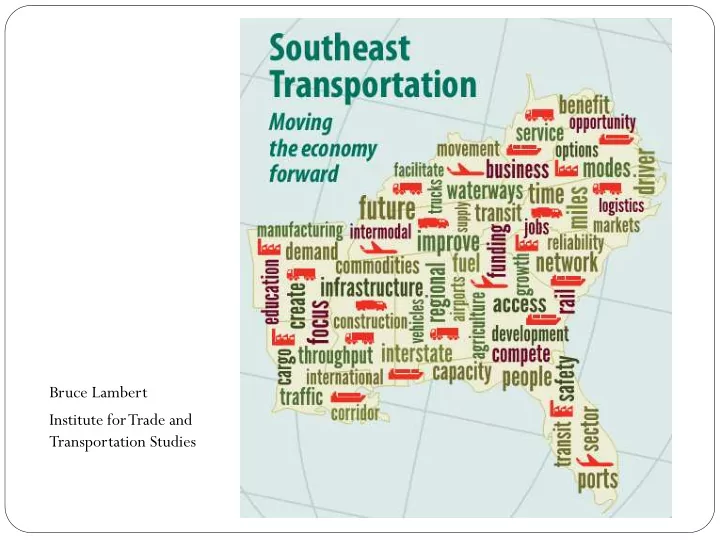

Bruce Lambert Institute for Trade and Transportation Studies
Why the Southeast Matters? Demographics Workforce Greenfield Sites Intermodal Network Economic Development Efforts
The Southern Advantage (2003) Joe Hollingsworth, Jr. The South becomes even more competitive in the world economy 1. South shifts from manufacturing to service sector which improves 2. manufacturing Migration continues as the South becomes “land of opportunity” 3. South develops knowledge based economy 4. South leads way in education reform 5. Contiguous counties around major 6. metropolitan areas will be the action in the south South becomes practically the only 7. location for automotive plants
Comparison of Freight Dependency between the US, Southeast, 2010 45% 40% 35% 30% 18.8% 18.3% 25% 20% 15% 10% 19.6% 17.5% 5% 0% US Average Southeast Average Consuming Producing
SASHTO States Outperformed US in … (%Change 2000-2010) 0.6 50.8% 47.2% 0.5 38.3% 0.4 34.9% 0.3 23.5% 21.3% 0.2 0.1 0 Manufacturing Logistics All Industries United States southeast
Growth in Total Exports (07-11) US 29% Southeast 41%
The Automotive Industry has a Southern Face Northern- US Firms Southern – Foreign Firms
Foreign Direct Investment- Thousand Jobs (2010) • Transportation needs vary • Like to locate near “neighbors” • Tend to use more import sourcing
The Result… More stuff moving in the Southeast Annually Everyone - consumes 50 tons of stuff (2 Trucks) 11,000 ton-miles (driving between LA and Charleston 5 times!) 9% of US GDP spent on logistics
DOT’s have two questions they need to answer concerning freight: 1. How do I help my businesses grow 2. How do I offset “through” cargo on my network
Planning for Freight- Today All Modes All cargos More modal balance Discretionary Largest trading routing partners are neighbors To-From State Through Freight 34% 33% Within State Mostly Trucks 33% Tend to be heavier products Rural-urban flows Urban-urban flows
Logistics Parks and Economic Development What type of facility? Trackage and Terminals Develop densities Need partners
No One Industry Along A Corridor http://www.wired.com/magazine/2011/05/ff_jobsi85/
Planning for Tomorrow Internal ernal - What t do I need to know w toda oday y External ernal -What hat external ernal fa fact ctor ors will ll to help lp my busines nesses ses tomo morr rrow? influence fluence traf affic c throug ugh h my syst stem em Rural truck S&W Export traffic? Intermodal terminals Panama Canal Permitting Nearshoring – Inshoring? Land use decisions Energy policy
Potential Changing Hinterlands from the Panama Canal?
Corridors will be more important in the future Intermodal/ inland ports developments Economic Growth Poles/Clusters Emergence of National Logistics Hubs Changing Urban and Rural demographics How do you plan for the unknown
Trucks in Little Rock in 24 Hours
Regional Operations are no laughing matter… Lost productivity for all involved!!
ATRI - 100 Bottlenecks for Trucks Where does congestion influence operations?
Multimodal – Through Traffic Issues Need to consider modal interchanges No funding for alternative modal routing frameworks Local TS&W permits Need to understand how system works to fully address transportation needs
MAP-21 Freight Provisions National Freight Policy Establishment of a National Freight Network Critical Rural Freight Corridors National Freight Strategic Plan Freight Transportation Conditions and Performance
Summary The Southeast depends upon Freight Freight does not recognize political boundaries by infrastructure lanes Federal Policy moving to support efficiency, not equity, in transportation spending Regional collaboration demonstrates value to Federal, State and Locals Me You More
Bruce Lambert Executive Director Institute for Trade and Transportation Studies 540-455-9882 bruce@ittsresearch.org Visit ittsresearch.org for: Newsletter State Statistics Reports and Presentations
Recommend
More recommend